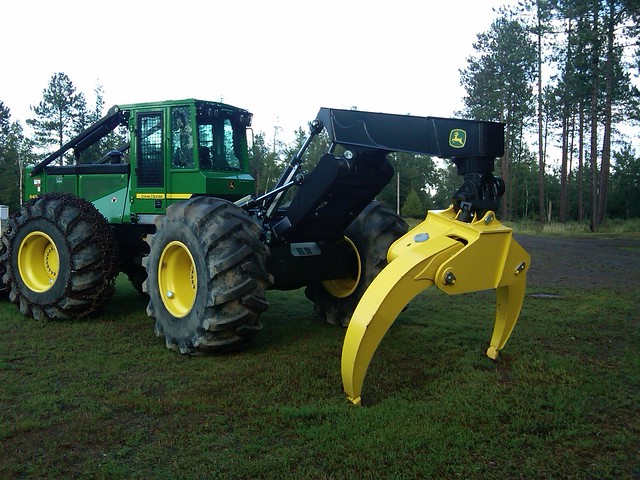(My apologies for the formatting - the text wouldn't align
to the left when placed above the video)
To answer a few of these questions I looked for some relevant videos and images. Above is a video of a feller buncher. As shown in the video, it cuts trees near their bases and holds them while it cuts a few more. Eventually, these trees are placed down and more are cut. The video gives a sense of how powerful and efficient this machinery is. The trees begin to look like twigs as they are helplessly cut and dropped aside. I have used both axes and saws and this makes anything I've done look embarrassingly easy.
Above is a skidder. As mentioned by Schneider, this machine pulls the logs away. The pincers grasp a logs that have been placed into a stack and, as I understand it, drag them away by holding on to one end. It seems that there are multiple types of skidders (ones with chains, for instance), but the basic idea is to drag piles of logs away.
In looking into log driving, I found that the process involved a fair few moving parts. A group of men, divided into a boss, "log drivers", and a "rear crew." The boss would keep control of the group, particularly the more rowdy members. A driver's job was to keep the logs from getting stuck down the river. One log getting stuck could ultimately cause the formation of a small dam. Drivers used peaveys (poles used to prod and move logs) and even dynamite to keep things flowing. The rear crew were generally less experienced men, whose job was to push along any logs that fell behind for whatever reason. As demonstrated by Terrie, these jobs often had some risk involved, because of both the river and how the logs changed and interacted with it.
Sources:
-https://www.youtube.com/watch?v=QQmtEdOphy8
-https://c1.staticflickr.com/3/2648/3755882369_d45de852ae_z.jpg
-The Adirondacks: A History of America's First Wilderness, Paul Schneider
-http://en.wikipedia.org/wiki/Log_driving

These machines are really pretty amazing, and as a result of the fact that they do not require much effort to operate, loggers today as far as I have seen are a pretty unhealthy lot. Many of them smoke, drink gallons of soda from their cockpits, and generally care very little for their health. When I was maybe six or seven, my dad went to buy some lumber from a local sawmill. I still remember the guy who made the deal with us, because he had a hook for one of his hands. So I guess despite the fact that loggers are more removed from their operations than they used to be, it is still a fairly dangerous job.
ReplyDeleteI found the video to be a very powerful addition. It was borderline disturbing to see how easily and quickly trees could be spliced from the ground and transported. I feel as though reading increased my understanding of different logging strategies but the video really gave me an emotional impact.
ReplyDelete